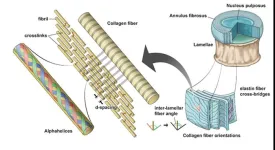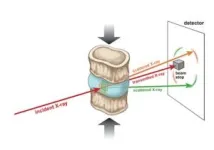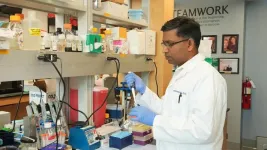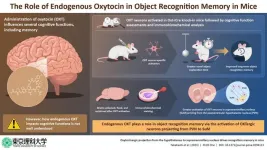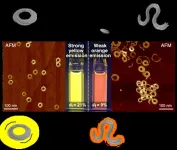(Press-News.org) Type 2 diabetes alters the behavior of discs in the vertebral column, making them stiffer, and also causes the discs to change shape earlier than normal. As a result, the disc’s ability to withstand pressure is compromised. This is one of the findings of a new study in rodents from a team of engineers and physicians from the University of California San Diego, UC Davis, UCSF and the University of Utah.
Low back pain is a major cause of disability, often associated with intervertebral disc degeneration. People with Type 2 diabetes face a higher risk of low back pain and disc-related issues. Yet the precise mechanisms of disc degeneration remain unclear.
Investigating the biomechanical properties of the intervertebral disc is crucial for understanding the disease and developing effective strategies for managing low back pain. The research team was co-led by Claire Acevedo, a faculty member in the Department of Mechanical and Aerospace Engineering at the University of California San Diego, and Aaron Fields, faculty in the Department of Orthopaedic Surgery at UC San Francisco.
“These findings provide novel insight into the potential mechanisms underlying diabetes-related disc tissue damage and may inform the development of preventative and therapeutic strategies for this debilitating condition,” the researchers write.
The study emphasizes that nanoscale deformation mechanisms of collagen fibrils accommodate compressive loading of the intervertebral disc. In the context of type 2 diabetes, these mechanisms are compromised, resulting in collagen embrittlement. These findings provide novel insight into the potential mechanisms underlying diabetes-related disc tissue damage and may inform the development of preventative and therapeutic strategies for this debilitating condition.
Researchers employed synchrotron small-angle x-ray scattering (SAXS), an experimental technique that looks at collagen fibril deformation and orientation at the nanoscale. They wanted to explore how alterations in collagen behavior contribute to changes in the disc's ability to withstand compression.
They compared discs from healthy rats to those from rats with Type 2 diabetes (UC Davis rat model). The healthy rats showed that collagen fibrils rotate and stretch when discs are compressed, allowing the disc to dissipate energy effectively.
“In diabetic rats, the way vertebral discs dissipate energy under compression is significantly impaired: diabetes reduces the rotation and stretching of collagen fibrils, indicating a compromised ability to handle pressure,” the researchers write.
Further analysis showed that the discs from diabetic rats exhibited a stiffening of collagen fibrils, with a higher concentration of non-enzymatic cross-links. This increase in collagen cross-linking, induced by hyperglycemia, limited plastic deformations via fibrillar sliding. These findings highlight that fibril reorientation, straightening, stretching, and sliding are crucial mechanisms facilitating whole-disc compression. Type 2 diabetes disrupts these efficient deformation mechanisms, leading to altered whole-disc biomechanics and a more brittle (low-energy) behavior.
The team published their findings in the December 2023 issue of PNAS Nexus.
This research was supported by the Research Allocation Committee at UCSF (A.J.F.), the Core Center for Musculoskeletal Biology and Medicine at UCSF (A.J.F.), the University of California Office of the President (P.J.H.), the National Institutes of Health (R01 DK095980, R01 HL107256, R01 HL121324, P30 AR066262, R01 AR070198), the University of Utah (J.L.R.), and the Advanced Light Source (ALS07392; T.N.A., C.A.).
Type 2 diabetes impairs annulus fibrosus fiber deformation and rotation under disc compression in the University of California Davis type 2 diabetes mellitus (UCD-T2DM) rat model
Claire Acevedo Department of Mechanical and Aerospace Engineering, University of California San Diego and James L. Rosenberg Departments of Mechanical and Biomedical Engineering, University of Utah
Eric Schaible Advanced Light Source, Lawrence Berkeley Laboratory
Alan Bostrom Ann A. Lazar Department of Epidemiology and Biostatistics, University of California San Francisco
James L. Graham Department of Molecular Biosciences and Department of Nutrition
Robert O. Ritchie Materials Science Division, Lawrence Berkeley National Laboratory and
Department of Materials Science and Engineering, University of California, Berkeley
Aaron J. Fields, Jeffrey C. Lotz, Tamara N. Alliston Department of Orthopaedic Surgery, University of California, San Francisco
*To whom correspondence should be addressed: Email: Claire.Acevedo@utah.edu(C.A.); Aaron.Fields@ucsf.edu(A.J.F.)
END
Type 2 diabetes alters the behavior of discs in the vertebral column
In a rat model, the discs became stiffer and changed shape earlier than normal
2024-02-13
ELSE PRESS RELEASES FROM THIS DATE:
Mount Sinai ophthalmologists develop novel protocol to rapidly diagnose and treat eye stroke
2024-02-13
Ophthalmologists at New York Eye and Ear Infirmary of Mount Sinai (NYEE) have created a novel protocol to rapidly diagnose eye stroke and expedite care to prevent irreversible vision loss.
Their study, published Tuesday, February 13, in Ophthalmology, describes using high-resolution retinal imaging in the emergency room, along with rapid remote consultation to confirm diagnosis and expedite care, improving outcomes for eye stroke patients and preserving vision.
“The protocol implements highly sensitive retinal imaging at the patient’s point of entry into the medical system, reducing the need for onsite ophthalmology ...
Scientists study the behaviors of chiral skyrmions in chiral flower-like obstacles
2024-02-13
In nature, the collective motion of some birds and fish, such as flocks of starlings and shoals of sardines, respectively, can generate impressive dynamic phenomena. Their study constitutes active matter science, which has been a topic of great interest for the past three decades. The unique collective dynamics of active matter are governed by the motion of each individual entity, the interactions among them, as well as their interaction with the environment. Recent studies show that some self-propelling molecules and bacteria show circular motion with a fixed chirality (the property of an object where it cannot be superimposed upon its mirror image through any number of rotations ...
If we can't untangle this mess, Norway's blue industry will never be green
2024-02-13
Lost fishing lines and ropes are a growing problem. As a leading fishing nation, Norway, with its long coastline and fish-rich waters, is particularly vulnerable to marine litter. A new study from the Norwegian University of Science and Technology (NTNU) shows that only a third of all ropes produced and sold in Norway can be recycled in a sustainable way.
The rest are burned, buried, sent out of the country - or just pile up and contribute to something called ghost fishing. That's when lost or abandoned fishing gear, floating in the ocean or anchored to the bottom, inadvertently continues to catch marine creatures long ...
National Foundation for Cancer Research (NFCR) celebrates Dr. Yung-Chi Cheng's three decades of pioneering research and recent partnership with Astrazeneca China
2024-02-13
The National Foundation for Cancer Research (NFCR) proudly celebrates the outstanding contributions of Dr. Yung-Chi Cheng, the Henry Bronson Professor of Pharmacology and Medicine at Yale University. Dr. Cheng's relentless dedication over the past three decades has led to an experimental botanical drug, YIV-906, to enter various phase II human trials and establishing a now clinical-stage platform biotechnology company committed to developing groundbreaking medicines targeting cancer and aging-related diseases.
NFCR has been a vital and steadfast supporter of Dr. Cheng's pioneering work, providing more than $2.5 MM ...
Sandalwood oil by-product prevents prostate cancer development in mice
2024-02-13
Extracted from the core of sandalwood trees (santalum album tree), sandalwood oil has been used for many centuries by several cultures throughout the world for perfume, soaps, incense and candles. With its earthy sweet scent, this essential oil also is used in the food industry and topically in various cosmetic preparations.
Importantly, this natural oil is known for its health benefits and medicinal applications from antibacterial to anticancer because of its phytochemical constituents. In addition to containing esters, free acids, aldehydes, ketones and santenone, sandalwood oil primarily (90 percent or more) constitutes santalol – ...
Low-cost microbe can speed biological discovery
2024-02-13
UNDER EMBARGO UNTIL 8AM EST ON FEB. 13, 2024
ITHACA, N.Y. – Cornell University researchers have created a new version of a microbe to compete economically with E. coli – a bacteria commonly used as a research tool due to its ability to synthesize proteins – to conduct low-cost and scalable synthetic biological experiments.
As an inexpensive multiplier – much like having a photocopier in a test tube – the bacteria Vibrio natriegens could help labs test protein variants for creation of pharmaceuticals, synthetic fuels and sustainable compounds that battle weeds or pests. The microbe can work effectively without costly incubators, shakers or deep freezers ...
Determining who gets blamed when cars hit pedestrians
2024-02-13
COLUMBUS, Ohio – A new study examines the circumstances behind who is found at fault when cars hit pedestrians in an urban area.
Results showed that the environment where the crash took place – especially the types of roads and the amount of access to marked crosswalks – played a key role in whether the pedestrian or the driver was blamed for the collision.
In the study, done in Columbus, pedestrians were more likely to be blamed when they were crossing roads with a high volume of cars traveling at faster speeds, and where crosswalks were few and far between.
In areas of the city – such as downtown – ...
Oxytocin: the love hormone that holds the key to better memory
2024-02-13
Oxytocin (OXT) is a hormone that is known for its effects on psychological well-being and emotional bonding in animals. Interestingly, research has shown that this natural chemical in the brain plays a crucial role in other cognitive processes as well, including learning and memory. Now, scientists may have discovered exactly how OXT influences memory in animals by studying “OXT neurons” that contain OXT receptors and function differently based on the availability of the chemical in the brain.
In a recent study published on 16 November 2023, in PLOS One, a group ...
Exploring the effect of ring closing on fluorescence of supramolecular polymers
2024-02-13
In supramolecular chemistry, the self-assembly state of molecules plays a significant role in determining their tangible properties. Controlling the self-assembled state has garnered significant attention as it can be exploited to design materials with desired properties like charge transport capability and fluorescence wavelength. For years, scientists have been trying to decipher how molecular organization impacts the properties of supramolecular assemblies that are in the nano (<10 nm) and mesoscopic (10–1000 nm) scales. However, the study of structures with supramolecular polymer assemblies derived from the same monomer is often hindered by dynamic structural ...
Frequent marine heatwaves in the Arctic Ocean will be the norm
2024-02-13
Marine heatwaves will become a regular occurrence in the Arctic in the near future and are a product of higher anthropogenic greenhouse-gas emissions – as shown in a study just released by Dr. Armineh Barkhordarian from Universität Hamburg’s Cluster of Excellence for climate research CLICCS.
Since 2007, conditions in the Arctic have shifted, as confirmed by data recently published in the journal Nature Communications Earth & Environment. Between 2007 and 2021, the marginal zones ...
LAST 30 PRESS RELEASES:
Why nail-biting, procrastination and other self-sabotaging behaviors are rooted in survival instincts
Regional variations in mechanical properties of porcine leptomeninges
Artificial empathy in therapy and healthcare: advancements in interpersonal interaction technologies
Why some brains switch gears more efficiently than others
UVA’s Jundong Li wins ICDM’S 2025 Tao Li Award for data mining, machine learning
UVA’s low-power, high-performance computer power player Mircea Stan earns National Academy of Inventors fellowship
Not playing by the rules: USU researcher explores filamentous algae dynamics in rivers
Do our body clocks influence our risk of dementia?
Anthropologists offer new evidence of bipedalism in long-debated fossil discovery
Safer receipt paper from wood
Dosage-sensitive genes suggest no whole-genome duplications in ancestral angiosperm
First ancient human herpesvirus genomes document their deep history with humans
Why Some Bacteria Survive Antibiotics and How to Stop Them - New study reveals that bacteria can survive antibiotic treatment through two fundamentally different “shutdown modes”
UCLA study links scar healing to dangerous placenta condition
CHANGE-seq-BE finds off-target changes in the genome from base editors
The Journal of Nuclear Medicine Ahead-of-Print Tip Sheet: January 2, 2026
Delayed or absent first dose of measles, mumps, and rubella vaccination
Trends in US preterm birth rates by household income and race and ethnicity
Study identifies potential biomarker linked to progression and brain inflammation in multiple sclerosis
Many mothers in Norway do not show up for postnatal check-ups
Researchers want to find out why quick clay is so unstable
Superradiant spins show teamwork at the quantum scale
Cleveland Clinic Research links tumor bacteria to immunotherapy resistance in head and neck cancer
First Editorial of 2026: Resisting AI slop
Joint ground- and space-based observations reveal Saturn-mass rogue planet
Inheritable genetic variant offers protection against blood cancer risk and progression
Pigs settled Pacific islands alongside early human voyagers
A Coral reef’s daily pulse reshapes microbes in surrounding waters
EAST Tokamak experiments exceed plasma density limit, offering new approach to fusion ignition
Groundbreaking discovery reveals Africa’s oldest cremation pyre and complex ritual practices
[Press-News.org] Type 2 diabetes alters the behavior of discs in the vertebral columnIn a rat model, the discs became stiffer and changed shape earlier than normal
